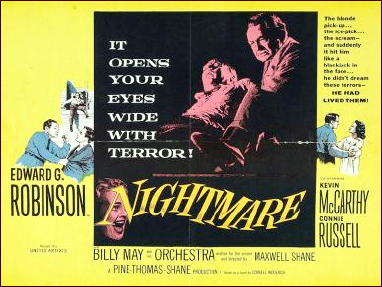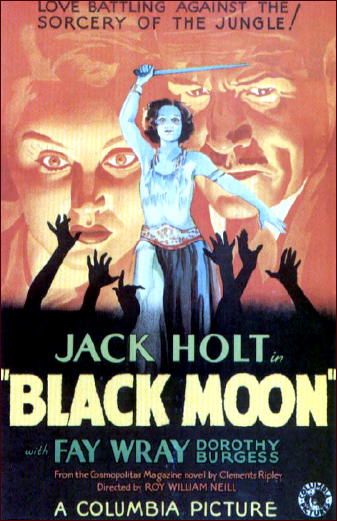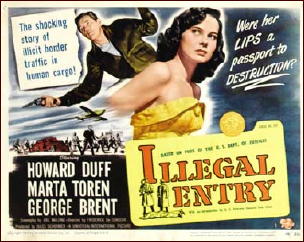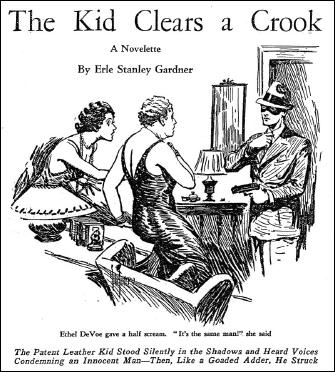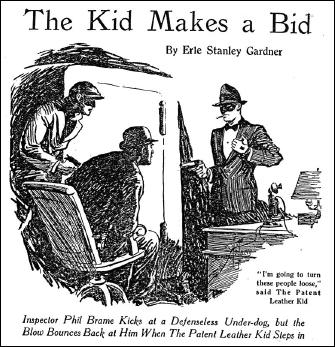December 2011
Monthly Archive
Sun 11 Dec 2011
REVIEWED BY WALTER ALBERT:
NIGHTMARE. United Artists, 1956. Kevin McCarthy, Edward G. Robinson, Connie Russell, Virginia Christine, Rhys Williams, Gage Clarke, Marian Carr, Meade “Lux” Lewis, Billy May and His Orchestra. Screenplay by Maxwell Shane, based on a story by Cornell Woolrich. Director: Maxwell Shane. Shown at Cinecon 39, Hollywood CA, Aug-Sept 2003.
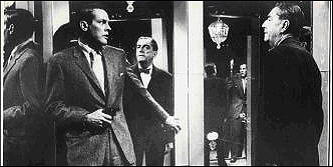
“We welcome Kevin McCarthy with a screening of this nifty noir mystery than (sic) crackles with the sense of paranoia that pervades much of Cornell Woolrich’s fiction.”
Oh, my. The film was scheduled when the program committee was unable to get permission to show Death of a Salesman. It was neither nifty nor did it crackle, but the Woolrich novel at least provided an interesting plot (musician/composer McCarthy dreams he’s committed a murder and eventually discovers the dream is apparently true), and Robinson, somewhat miscast but making the best of it, plays the detective brother-in-law of McCarthy who sifts through the damning scenario to unravel the plot that has ensnared and almost brings down McCarthy.
The location filming in New Orleans added some color to the film, and the appearance of Meade Lewis and Billy May spiced the film for their fans.
McCarthy was interviewed at some length about his film and theater career, and he was less obstreperous as an interview subject than he was reputed to be in his Hollywood years. He’s probably best known for Invasion of the Body Snatchers, but I don’t recall that he had much to say about the film.
Sun 11 Dec 2011
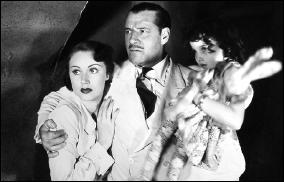
BLACK MOON. Columbia Pictures, 1934. Jack Holt, Fay Wray, Dorothy Burgess, Cora Sue Collins, Arnold Korff, Clarence Muse, Eleanor Wesselhoeft, Madame Sul-Te-Wan. Director: Roy William Neill.
This early voodoo movie is a little old-fashioned in its presentation — and you could even say out-and-out clunky and get away with it — but there some very some effective moments in Black Moon. Especially weird and strange are the scenes of native sacrifices, filmed against a backdrop of drums constantly beating on a fictional (though very Haiti-like) island in the Caribbean.
It’s easy to call Black Moon old-fashioned today, but when you think about it, how ready would audiences have been for a movie like this in 1934?
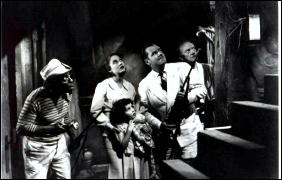
Isolated on the island is a small outpost of whites: a man; his young daughter; his secretary (secretly in love with him); his wife, who has been caught under the voodoo spell since she was child, even back in New York City; and her uncle, who owns a plantation on the island. (The young girl’s nanny barely counts, as she dies very early on.)
By old-fashioned, though, I mean (for example) the story moves only in fits and starts, and one can easily wonder why everyone stays so calm (relatively speaking) when the deaths and the other strange and eerie events begin. (Some things have never changed in movies like this, not since day one.)
Of the actors, Jack Holt does stolid well. Fay Wray as his secretary and the exotic Dorothy Burgess as his wife provide the beauty, and this they do very well, maybe even better.
Sat 10 Dec 2011
Posted by Steve under
Reviews[2] Comments
THE ARMCHAIR REVIEWER
Allen J. Hubin
BILL PRONZINI – Jackpot. Delacorte, hardcover, 1990. Dell, paperback, 1991.
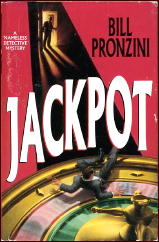
Bill Pronzini will find it tough indeed to top his scintillating 1988 “Nameless” novel, Shackles, and he doesn’t with the next, Jackpot, but by any other standard this is a very tasty morsel.
Nameless is still, months after his harrowing experiences in Shackles, undergoing anxiety attacks and learning new things — not all gratifying — about himself.
He needs to keep busy at work so his mind is distracted, and he takes on a nothing case as a favor to his friend Kerry. It seems that an otherwise very ordinary chap named David Burnett won $200,000 in a Lake Tahoe casino, then lost it all and more somehow, and committed suicide.
It’s very plainly suicide, but David’s sister doesn’t believe it, and Nameless, more as a comfort than anything else, agrees to check a few things. The more he checks, the more odor of fish turns up, and in due course it’s likely to be the stink of death, probably his.
Very smooth and observant narrative.
— Reprinted from The MYSTERY FANcier,
Vol. 12, No. 4, Fall 1990.
Sat 10 Dec 2011
Posted by Steve under
Reviews[2] Comments
THE BACKWARD REVIEWER
William F. Deeck
ANITA BLACKMON – Murder à la Richelieu. Doubleday Crime Club, hardcover, 1937. William Heinemann, UK, hardcover, 1938, as The Hotel Richelieu Murders.
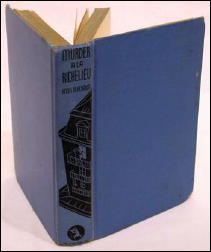
As the oldest and richest resident of the Hotel Richelieu, Miss Adelaide Adams, a spinster sometimes called the “Old Battle-Ax,” sees all and knows all of what goes on in the hotel. Oh, except for the blackmailing, the prostitution, the body in her room hanged and with its throat slit, the — but to go on would be to give away an essential plot element.
Two more murders occur, both of the victims like the first killed twice, if such a thing is possible. Almost as bad, Miss Adelaide is discovered several times minus her false hair and teeth.
Miss Adelaide detects in her own way. She’s a lot like Louisa Revell’s Miss Julia Tyler — rather inept. Still, it’s through her efforts that the killer is unmasked. A quite enjoyable novel, and I am beginning a search for Blackmon’s only other mystery, also featuring Miss Adelaide.
Warning: The setting here is the South, probably the Deep South. At one point Miss Adelaide says, “…no well brought-up Southern woman ever read Uncle Tom’s Cabin or allowed that obnoxious book to be mentioned in her presence.” The lady’s views on blacks are those of the times and the place, which, alas, were not enlightened.
— From The MYSTERY FANcier, Vol. 12, No. 4, Fall 1990.
NOTE: The other mystery-solving adventure of Miss Adelaide referred to by Bill was There Is No Return (Doubleday, 1938). For a long, detailed overview of Anita Blackmon’s writing career, check out this post by Curt Evans which appeared earlier on this blog.
Sat 10 Dec 2011
IT IS PURELY MY OPINION
Reviews by L. J. Roberts
ANNA DEAN – A Woman of Consequence. Allison & Busby, UK, hardcover, 2010. St. Martin’s/Minotaur, US, hardcover, April 2012.
Genre: Historical Mystery. Leading character: Miss Dido Kent; 3rd in series. Setting: England, 1806–Georgian era.
First Sentence: My dear Eliza, I promised yesterday that just as soon as I had leisure for writing should send you a full and satisfactory account of Penelope Lambe’s accident at Madderstone Abbey; and so I shall begin upon it.
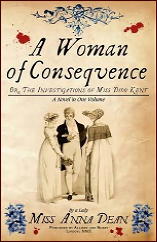
Unconscious after Penelope Lambe falls down stone steps in the ruin of Madderstone Abbey, it is thought she saw the ghost of the Grey Nun. Miss Dido Kent is skeptical and believes the cause was more corporal than spiritual.
When a skeleton, identified as Elinor Fenn, governess, is found within a lake being drained on the property, the verdict is self-murder. A friend does not believe Miss Fenn would have committed suicide and, in order to save her being buried in unconsecrated ground, asks Dido to investigate.
With a wonderful opening, I am reminded how much I enjoy the voice of Anna Dean and, therefore, her character Dido Kent. With shades of Jane Austen and her own delightful, wry humor, we are transported back to Georgian England… “I believe that every family which has any claim at all to grandeur should have a ghost. I consider it a kind of necessary which should be attended to as soon as the fortune is made and the country estate purchased.â€
Ms. Dean writes her books in both third person narrative and first person through letters from Dido to her sister. While some may find this annoying, for me it is an interesting and amusing way of conveying relevant information without slowing down the story. It allows us to see both all the events and be privy to Dido thoughts at the same time.
At 36 years old, Dido is considered a spinster, yet is anything but shy and retiring. She has a logical mind and approach to solving problems by investigating the clues. The secondary story of her relationship with Mr. Lomax provides an interesting look at relationships and social mores of the time. Mr. Lomax discomfort at Dido discussing “unsuitable†subjects, including the vulnerability of women, and the proprietary of the interactions between them are both delightful and most honest representations I have read.
Ms. Dean has written a mystery of twists and turns, of relationships and unexpected revelations. I was intrigued by some of the history, particularly the doctor trying to determine the cause of asthma.
With more substance than a cozy, this was a very good traditional mystery. I anxiously await her fourth book.
Rating: Very Good.
The Dido Kent series —
1. A Moment of Silence (2008). Published as Bellfield Hall in the US.
2. A Gentleman of Fortune (2009)
3. A Woman of Consequence (2010)
Fri 9 Dec 2011
REVIEWED BY DAN STUMPF:
Five JACKIE CHAN Kung-Fu Movies
I saw something the other day I never knew existed: An intelligent Kung-Fu Movie. After seeing his segment on the TV series The Incredibly Strange Film Show, I finally found a couple Jackie Chan films at a local video store and rented them.
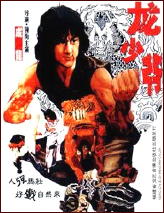
I should confess at the outset that I used to watch Kung-Fu movies on a semi-regular basis, and mildly enjoyed them, despite their almost total lack of competence, but if anyone had told me there existed martial arts films with wit and humor, I wouldn’t have believed them, particularly after watching the first four films mentioned here.
Dragon Lord was only mildly disappointing, with long stretches of supposedly witty banter between Jackie Chan and his buddy, both of whom rather improbably play juveniles.
As you might expect, whatever wit there may have been in the original dialogue got fumbled in translation. Also the pan-and-scan is woefully inadequate at times. There are a couple of imaginative action scenes, though, including one where Jackie sneaks across a roof while bad guys inside thrust spears up at him.
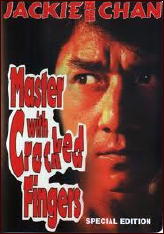
In all, while this was nothing to write home about, it was not bad enough to keep me from watching other Jackie Chan movies.
Master with Cracked Fingers seems to be an earlier film, and is completely routine Kung-Fu stuff. I wouldn’t show it to my dog, but it did remind me of a conundrum of the genre:
In this and most other Kung-Fu flicks, there’s almost always a climactic battle with the hero or heroes fighting it out — sometimes two or three against one — with some aged character who looks like the Chinese equivalent of Lionel Barrymore. Can any of you Orientalists out there tell me why it seems so particularly important and praiseworthy for Martial Artists to drub these old duffers?
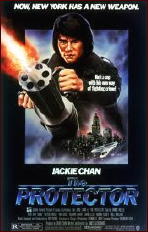
The Protector was a conscious attempt by Chan to break into the American market, and to this end Danny Aiello was hired to co-star. (Yeah, that’ll pack ’em in.)
Unfortunately, the producers forgot to write a part for Aiello, so he spends the film standing around saying things like “You’re the boos, Jackie,” “Right behind you, Jackie,” and “Here it is, Jackie.”
Jay Silverheels got better lines than that! The film itself is suffused with a modest sheen of competence, but the plot and characterization are so routine as to have been done by rote.
Fantasy Mission Force, on the other hand, is almost bad enough to be good. It’s set in World War II. Everyone drives brightly-colored Suzuki Jeeps with roll bars, and one of the Generals wears a Civil War uniform, but it’s supposed to be WWII.
The plot, such as it is, involves a super-Commando (not Jackie Chan) assigned to rescue four allied Generals kidnapped by Japanese Nazis(!) in Luxembourg, which, it turns out, has no cities but lots of dense jungle and bamboo huts.
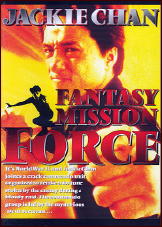
To this end, the Super-Grunt recruits a force of spectacularly incompetent outlaws in a variety of period costumes, and they all set out for wherever the Generals are being held.
From this point on, the plot gets a little strange, as the World War II Commando Force encounters Cannibal Amazons, Ghosts, Punk Road Warriors in beat-up Ford Mustangs, and a wandering chicken thief played (about time!) by Jackie Chan.
As I say, it’s almost bad enough to enjoy, but ultimately the lack of enthusiasm on the part of all concerned in its making sinks this one.
So finally we get to Police Force (aka Jackie Chan’s Police Force, aka Police Story), which is quite simply an intelligent, imaginative Action Film, on a par with the best of the James Bond’s, or just about any French Thriller, with lots of visual gags and a couple of actual developed characters.
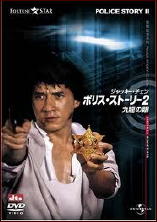
Police Force also features some very imaginatively-staged action scenes, including the destruction of a hillside village by driving little cars through it, and the similar trashing of a multi-floor mega-mall in an extended fistfight.
As for the Star himself, Jackie Chan emerges here as a sort of Asiatic Belmondo, complete with klutzy machismo, self-deprecating humor, and an insistence that all his action scenes be shot so as to show that he’s not using a stunt man.
It’s a device that’s been used before, notably by such cinematic athletes as Doug Fairbanks and Fred Astaire, and it’s rather well suited to the straight Action Film. I had to wade through a lot of celluloid slop to get there, but Police Force was worth the trip.
— Reprinted from
A Shropshire Sleuth #52, March 1992.
â— DRAGON LORD. Authority Films, 1982. Also released as Dragon Strike; original title: Long xiao ye. Starring, co-written by and directed by Jackie Chan.
â— MASTER WITH CRACKED FINGERS. Soon Lee Films, 1971. Original title: Guang dong xiao lao hu. Jackie Chan, Siu Tien Yuen. Director: Mu Zhu.
â— THE PROTECTOR. Golden Harvest Company, 1985. Jackie Chan, Danny Aiello, Sandy Alexander. Director: James Glickenhaus.
â— FANTASY MISSION FORCE. Cheung Ming Films, 1982. Original title: Mi ni te gong dui. Jackie Chan, Brigitte Lin. Director: Yen-ping Chu.
â— POLICE FORCE. Golden Way Films Ltd., 1985. Also released as Police Story. Original title: Ging chat goo si. Jackie Chan, Brigitte Lin. Director: Jackie Chan.
Fri 9 Dec 2011
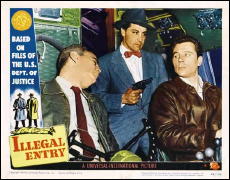
ILLEGAL ENTRY. Universal, 1949. Howard Duff, Märta Torén, George Brent, Gar Moore, Tom Tully, Paul Stewart. Director: Frederick De Cordova.
Director Frederick De Cordova is, of course, far better known for his work producing and directing on TV than in the movies, and even then more for his work in comedy (Jack Benny, Johnny Carson) than for fare of a more criminous nature. This semi-documentary near-noir film about illegal immigration into California in the late 1940s was never his usual stock in trade, by far.
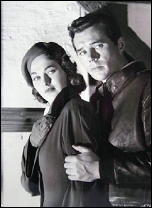
Nor is anything more than average all the way around, even with a host of recognizable names and faces for movies of this type, including star Howard Duff, he with the voice of Sam Spade and the quizzically uplifted eyebrows.
As a former Air Force pilot Bert Powers, Duff is asked to work undercover to get the goods on a ruthless gang of illegal alien importers — so ruthless are they as to drop their freight out of an open door if they feel the feds are getting too close.
The reason he’s brought in is because Märta Torén, the widow of a good buddy of Powers, is somehow connected with the gang. And indeed she is, but not willingly, which gives Powers all kinds of false signals, to his complete frustration.
There’s nothing deep involved in this tale, which is competently told, but unless you’re a fan of any of the players, you’ll forget it almost as soon as the bad guys have been caught. Forgive me for giving the ending away just now, but as you well know, you’d be much more surprised if they weren’t.
Fri 9 Dec 2011
Posted by Steve under
ReviewsNo Comments
NICOLE BYRD – Widow in Scarlet. Berkley, paperback original; 1st printing, September 2003.
Taking the title first, there are in fact, two widows in scarlet that appear in this rather long romantic adventure, set in England’s famed Regency era.
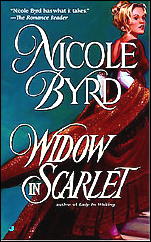
The first is poverty-stricken Lucy Contrain, whose husband died an untimely death a year before. The second is the famed “Scarlet Widow,” a fabulous ruby purchased by the Prince Regent, but which managed to disappear while it was on its way to England.
Accusing Lucy’s late husband of collaborating with the gang of thieves and murderers he believes was involved is Nicholas Ramsey, Viscount Richmond, a man whose reputation as a ladies’ man and seductor hides a highly capable agent of the prince.
Lucy is at first amazed and then determined to aid the viscount in his investigations — an unlikely pair of sleuths, to be sure, but the mother-and-daughter team who write jointly as Nicole Byrd skillfully gloss over any quibbles that might arise in the minds of picky readers, such as myself.
More satisfying than the mystery or its solution — of which the prologue reveals far too much — is the attraction that grows between the two protagonists, in fits and starts, but in true fashion of the day.
Widow in Scarlet is recommended more, therefore, for its intended audience, Regency romance enthusiasts, than it is for anyone actually reading this review — devotees of detective tales all, I’m sure — but for the former, the spirited adventure will be all the more icing on the cake.
Thu 8 Dec 2011
THE SERIES CHARACTERS FROM
DETECTIVE FICTION WEEKLY
by MONTE HERRIDGE
#9. THE PATENT LEATHER KID, by Erle Stanley Gardner.
The Patent Leather Kid is another leading character created by Erle Stanley Gardner. Someone with that identity first appeared in “The Gems of Tai Lee,†a story in the March 25, 1930, issue of Clues, but when the Kid showed up again, in the May 28, 1932, issue of Detective Fiction Weekly, he was a new character, the star of the first of a series of adventures that ended two years later.
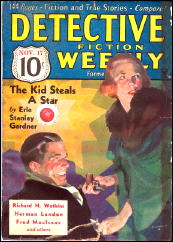
He had a dual identity in the DFW stories – normally rich Dan Seller most of the time, and The Patent Leather Kid when he is ready for one of his somewhat illegal adventures. The patent leather in the name comes from his wearing not only patent leather shoes but also a patent leather face mask to hide his identity.
The Patent Leather Kid “was always on the lookout for adventure, and anything sufficiently out of the usual called him with an irresistible attraction.†(The Kid Stacks a Deck)
There is a cast of regular characters for each of his identities. The stories usually start out with a scene of Dan Seller and his fellows at their club, discussing the latest criminal event or activity. The other club members are firstly Police Inspector Phil Brame, then Renfroe the bank president, and Bill Pope the explorer.
Brame usually brings up a criminal event, which causes disagreement among the others and ends with Seller or Bill Pope often betting on the outcome with him. Brame always loses these bets, but that does not keep him from trying again. Renfroe agrees with the Inspector much of the time, but also tries to avoid antagonizing Seller because he is a large depositor in his bank. It is not revealed how well off Dan Seller is, or where his money comes from.
In his identity of the Patent Leather Kid, he has another group of people. There is Bill Brakey, The Kid’s bodyguard and assistant. He is also called “A walking encyclopedia of the underworld,†and this comes in handy for The Kid’s adventures. Brakey usually knows the answer to any question about the underworld, or can get the information easily.
Another person in this group is Gertie, the telephone operator in his apartment house. She keeps track of his messages and also keeps an eye on The Kid’s special elevator which was constructed for his own use. She also knows his identity as Dan Seller. Interestingly, Gertie is also the name of Perry Mason’s telephone operator.
There are only three people in the apartment house hotel who know Dan Seller’s dual identity: Bill Brakey, Gertie, and the desk clerk who is never named.
The Patent Leather Kid lived in an apartment house hotel penthouse, with his special security extras such as a steel door and alarms systems. According to one story (The Kid Clips a Coupon), with these security arrangements: “no one could get through the roof without a warning coming over the telephone, without an automatic alarm shrilling a strident warning should the only elevator which communicated with the penthouse start on its way without The Kid’s having first unlocked an electrical contact.â€
The stories involve various kinds of adventures. In “The Kid Clears a Crook,†a reformed criminal trying to go straight is framed and taken advantage of by underworld crooks, and the police don’t care. The Kid sets out to clear the ex-crook and set the blame where it belongs, thereby infuriating both the underworld and the police.
Neither group likes interference from The Kid in their affairs, and try repeatedly to eliminate him. The police even (according to Inspector Brame) give the underworld the green light to eliminate The Kid, but this never happens. Brame even states that if they catch the Kid, they will frame criminal charges on him in order to keep him in jail for a long time.
The Kid enjoys this, in his words: “In this game of matching wits with the law, The Patent Leather Kid found his most fascinating recreation. He gambled with life and liberty, and enjoyed the game.†(The Kid Stacks a Deck) So the acquisition of money or property gained illegally is definitely not the goal of The Kid.
The first story to appear in DFW, “The Kid Stacks a Deck,†is a bit different than the others in the series. Bill Brakey does not appear in this story, and Gertie is present but not named. Inspector Brame is given the title of Commissioner, which he loses in later stories. Possibly the author thought the stories more effective with a lower ranking policeman.
In the story, The Kid finds out that a criminal gang is out to kill him, so he sets a trap for them. He breaks into a jewelry store, steals a few items and mails them to Brame and his family. The gang is waiting outside to shoot and rob him as he leaves. However, The Kid alerts the police who attack and wipe out the gang as The Kid escapes.
The story presents the image of The Kid as a master burglar without peer in the underworld and with a high reputation for those talents. However, he seems to have gained nothing from his burglary of the jewelry store. In fact, a point is made throughout the series that “The police had never been able to brand him specifically as a crook. He was a big shot, and his ways were the ways of the underworld, but they had never as yet pinned any definite crime upon him.†(The Kid Wins a Wager)
Inspector Brame’s chief complaint about The Patent Leather Kid was that his activities damaged the dignity of the police and made them look bad and caused people (and The Kid) to laugh at them. That was a terrible offense to Brame. He seems to have cared more about the dignity of the police department than anything else.
In “The Kid Throws a Stone,†The Kid is involved in a case where someone is impersonating him. The impersonator has already pulled one robbery before the real Patent Leather Kid starts his complex counter-offensive.
In another case of impersonation told in “The Kid Wins a Wagerâ€, a criminal burglarizes a jewelry story and leave a note supposedly signed by The Patent Leather Kid. Fortunately, The Kid catches him in the act and clears that up.
One of The Kid’s favorite tactics was to get criminals, who are after him, into confrontations with the police, where they invariably wind up shot. Rarely does The Kid have to use a gun on the criminals themselves, but this does occur in the story “The Kid Cooks a Goose,†where he and Bill Brakey are trying to protect a woman from a gang of killers. They shoot it out with the three killers and wipe out the gang.
This is a fun series, and Gardner is obviously enjoying himself writing these improbable situations. On a “Writer’s Almanac” episode on NPR (National Public Radio), Garrison Keillor quotes Gardner as saying about his pulp work: “I write to make money, and I write to give the reader sheer fun.”
The Patent Leather Kid series by Erle Stanley Gardner:
The Gems of Tai Lee Clues, 25 March 25 1930 [This story features a different “Patent Leather Kid,†as it turns out. See comment #12.]
The Patent Leather Kid discussed above appeared as a character only in Detective Fiction Weekly:
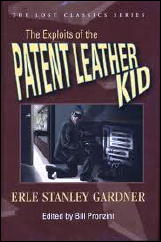
The Kid Stacks a Deck May 28, 1932
The Kid Passes the Sugar July 16, 1932
The Kid Wins a Wager September 10, 1932
The Kid Throws a Stone October 22, 1932
The Kid Makes a Bid February 18, 1933
The Kid Muscles In April 15, 1933
The Kid Takes a Cut May 20, 1933
The Kid Beats the Gun August 5, 1933
The Kid Covers a Kill November 4, 1933
The Kid Clears a Crook February 3, 1934
The Kid Clips a Coupon April 21, 1934
The Kid Cooks a Goose July 14, 1934
The Kid Steals a Star November 17, 1934
NOTE: The 13 stories that appeared in Detective Fiction Weekly have been collected in The Exploits of the Patent Leather Kid, edited by Bill Pronzini (Crippen & Landru, 2011).
Previously in this series:
1. SHAMUS MAGUIRE, by Stanley Day.
2. HAPPY McGONIGLE, by Paul Allenby.
3. ARTY BEELE, by Ruth & Alexander Wilson.
4. COLIN HAIG, by H. Bedford-Jones.
5. SECRET AGENT GEORGE DEVRITE, by Tom Curry.
6. BATTLE McKIM, by Edward Parrish Ware.
7. TUG NORTON by Edward Parrish Ware.
8. CANDID JONES by Richard Sale.
Thu 8 Dec 2011

Masters of the “Humdrum” Mystery: Cecil John Charles Street, Freeman Wills Crofts, Alfred Walter Stewart and the British Detective Novel, 1920-1961, by Curt Evans
Publisher: McFarland
Print ISBN: 978-0-7864-7024-2
EBook ISBN: 978-0-7864-9089-9
ca. 35 photos, appendices, notes, bibliography, index
softcover (7 x 10) 2012
Price: $49.95
Not Yet Published, Available Spring/Summer 2012
About the Book:
In 1972, in an attempt to elevate the stature of the “crime novel,” influential crime writer and critic Julian Symons cast numerous Golden Age detective fiction writers into literary perdition as “Humdrums,” condemning their focus on puzzle plots over stylish writing and explorations of character, setting and theme. This volume explores the works of three prominent British “Humdrums” — Cecil John Charles Street, Freeman Wills Crofts, and Alfred Walter Stewart — revealing their work to be more complex, as puzzles and as social documents, than Symonds allowed. By championing the intrinsic merit of these mystery writers, the study demonstrates that reintegrating the “Humdrums” into mystery genre studies provides a fuller understanding of the Golden Age of detective fiction and its aftermath.
About the Author:
Curt Evans, an independent scholar and book dealer, is the author of one book and numerous articles and essays on detective fiction.�����
« Previous Page — Next Page »

